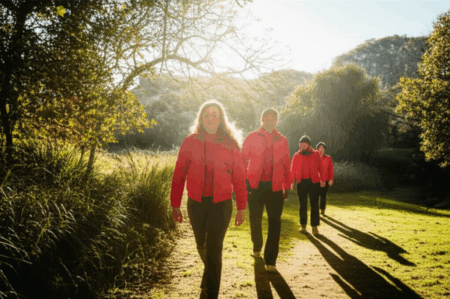Walking, often underestimated as a simple activity, is a powerhouse of health benefits. Incorporating regular walking into your fitness routine can lead to significant improvements in both physical and mental well-being. It’s accessible, free, and requires no special equipment, making it a perfect exercise for people of all ages and fitness levels. Let’s explore the many ways walking can enhance your life.
The Remarkable Physical Benefits of Walking
Walking offers a wide array of physical health benefits, contributing to a longer, healthier life.
Weight Management and Body Composition
Regular walking is an effective tool for maintaining a healthy weight and reducing body fat.
- Calorie Burning: Walking burns calories, with the number varying based on your pace, distance, and weight. A brisk 30-minute walk can burn approximately 150 calories. The more you walk and the faster your pace, the more calories you’ll expend, aiding in weight loss and preventing weight gain.
- Belly Fat Reduction: Aerobic exercises like walking are particularly effective at reducing visceral fat, the dangerous fat around your abdominal organs. Studies show that consistent aerobic activity, such as walking three times a week for 30-60 minutes, significantly reduces visceral adipose tissue.
- Long-Term Weight Management: Walking helps maintain weight loss. People who sustain a loss of at least 30 pounds for over a year often increase their physical activity, primarily through walking.
Cardiovascular Health
Walking is excellent for your heart, reducing the risk of heart disease and stroke.
- Reduced Risk of Cardiovascular Events: Walking regularly lowers the risk of cardiovascular events like heart attacks and strokes. Research indicates that walking enough to meet physical activity guidelines can reduce the risk of cardiovascular events by 30%.
- Improved Blood Pressure: Regular walking can lower blood pressure. Studies show that people who walk more have lower systolic blood pressure than those who walk less.
- Better Cholesterol Levels: Walking improves cholesterol levels. It helps increase levels of high-density lipoprotein (HDL) cholesterol, the “good” cholesterol, while reducing levels of low-density lipoprotein (LDL) cholesterol, the “bad” cholesterol.
- Strengthened Heart Muscle: Walking can strengthen the heart muscle, improving its efficiency and reducing the risk of death from cardiovascular events.
Disease Prevention and Management
Walking plays a crucial role in preventing and managing various chronic diseases.
- Diabetes Prevention and Management: Walking helps lower blood sugar levels and improve insulin sensitivity, reducing the risk of type 2 diabetes. Even short walks after meals can significantly lower blood sugar. The American Diabetes Association recommends walking to lower blood sugar levels and reduce the overall risk for type 2 diabetes.
- Cancer Risk Reduction: Regular walking is associated with a reduced risk of developing certain cancers.
- Osteoporosis Prevention: As a weight-bearing exercise, walking strengthens bones and helps maintain bone density, reducing the risk of osteoporosis and fractures.
- Reduced Risk of Chronic Conditions: Walking can reduce the risk of chronic conditions, including obesity, sleep apnea, gastroesophageal reflux disease (GERD), major depressive disorder (MDD), type 2 diabetes, and hypertension.
Enhanced Musculoskeletal Health
Walking strengthens muscles and improves joint health.
- Strengthened Bones and Muscles: Walking strengthens bones and muscles, particularly in the legs and core.
- Improved Muscle Endurance: Regular walking improves muscle endurance, allowing you to perform physical activities for longer periods without fatigue.
- Joint Pain Relief: Walking can alleviate joint pain and stiffness, benefiting people with arthritis. It lubricates and strengthens the muscles that support the joints, stabilizing and protecting them from further damage.
- Improved Balance and Coordination: Walking enhances balance and coordination, reducing the risk of falls and injuries.
Increased Energy Levels and Longevity
Walking boosts energy levels and contributes to a longer life.
- Boosted Energy: Walking increases oxygen flow through the body and elevates levels of hormones like epinephrine and norepinephrine, which regulate the central nervous system and increase energy levels.
- Increased Lifespan: Studies suggest that regular walking can add years to your life. Walking for 160 minutes daily could increase lifespan by approximately five years. Even small improvements in daily walking are beneficial, with the least active individuals potentially adding up to 11 years to their lives by becoming more active.
The Mental and Emotional Uplift from Walking
Beyond the physical benefits, walking significantly improves mental and emotional well-being.
Mood Enhancement and Stress Reduction
Walking is a natural mood booster and stress reliever.
- Reduced Stress and Anxiety: Walking reduces the stress hormone cortisol, helping you feel less stressed and more relaxed. It can also alleviate symptoms of anxiety.
- Improved Mood: Physical activity, including walking, triggers the release of brain chemicals that make you feel happier and more relaxed.
- Distraction from Negative Thoughts: Walking can distract you from negative thoughts, providing a mental break and promoting a more positive outlook.
Cognitive Benefits
Walking enhances cognitive function and protects against mental decline.
- Improved Memory and Focus: Regular walks can improve memory, attention span, and problem-solving skills.
- Reduced Risk of Dementia: Walking regularly lowers the risk of developing dementia and Alzheimer’s disease. It strengthens connections between brain circuits, improving overall brain health.
- Enhanced Creativity: Walking can clear your mind and encourage creative thinking.
Mental Health Support
Walking can be an effective tool in managing mental health conditions.
- Reduced Symptoms of Depression: Walking, even for short distances, benefits mental health. Taking as few as 1,000 steps daily can decrease depression.
- Sense of Accomplishment: Carving out time for a walk provides a sense of achievement, boosting self-esteem.
- Social Connection: Walking with others offers opportunities for social interaction, reducing feelings of loneliness and isolation.
Getting Started: Incorporating Walking Into Your Daily Routine
Making walking a regular part of your life is easier than you think. Here are some practical tips to get started and stay motivated:
Setting Realistic Goals
Start small and gradually increase your walking duration and intensity.
- Start Slowly: If you’re new to regular exercise, begin with short walks of 5-10 minutes at a comfortable pace. Gradually increase the time and distance over several weeks.
- Set Achievable Goals: Set realistic goals, such as walking for 20-40 minutes five days a week.
- Track Your Progress: Use a pedometer, fitness tracker, or smartphone app to track your steps and monitor your progress.
Making Walking a Habit
Incorporate walking into your daily routine to make it a sustainable habit.
- Find Specific Times for Walks: Schedule walks into your day, such as during your lunch break or after dinner.
- Walk Part of Your Commute: Walk to work or to the shops, or get off the bus or train one stop earlier and walk the rest of the way.
- Use Stairs Instead of Elevators: Take the stairs whenever possible to add extra steps to your day.
- Park Further Away: Park your car at the far end of the parking lot to increase your walking distance.
Staying Motivated
Keep your walking routine enjoyable and engaging to stay motivated.
- Make It Enjoyable: Listen to music, podcasts, or audiobooks while you walk.
- Walk with Others: Invite a friend, family member, or neighbor to join you for walks.
- Join a Walking Group: Join a local walking group or health club to meet new people and stay motivated.
- Vary Your Route: Plan different walking routes for variety and to explore new areas.
- Add Challenges: Incorporate hills, stairs, or speed intervals into your walks to increase the intensity.
- Reward Yourself: Celebrate your progress and reward yourself for achieving your walking goals.
Proper Walking Technique and Safety
Ensure you’re walking safely and efficiently to maximize the benefits and prevent injuries.
- Warm-Up and Cool-Down: Start each walk with a 5-10 minute warm-up and end with a cool-down period.
- Stretch: Stretch your muscles after cooling down to improve flexibility and prevent soreness.
- Maintain Good Posture: Stand tall with your head up, looking forward, and your shoulders relaxed.
- Swing Your Arms Freely: Swing your arms naturally with a slight bend in your elbows.
- Wear Comfortable Shoes: Wear comfortable, supportive shoes that fit well and provide good cushioning.
- Stay Hydrated: Drink water before, during, and after your walk.
- Be Aware of Your Surroundings: Walk in safe, well-lit locations and be mindful of traffic and other hazards.
- Tell Someone Your Route: If you’re walking alone, inform someone of your route and expected return time.
Types of Walking Workouts
To keep your routine interesting and challenge your body in new ways, try different types of walking workouts.
- Brisk Walking: Walk at a moderately quick pace, faster than your average walking pace. You should be able to talk but not sing.
- Power Walking: Stand tall, relax your shoulders, and pull your abdominal muscles in slightly. Take shorter steps and swing your arms.
- Interval Walking: Alternate between periods of high-intensity walking and lower-intensity recovery periods.
- Hill Walking: Walk on hilly or mountainous terrain to burn more calories and work different muscle groups.
- Nordic Walking: Use specially designed poles, similar to ski poles, to engage your upper body while walking.
- Trail Walking: Walk on rural or coastal paths, such as in forests, parks, or woodlands.
- Weighted Walking (Rucking): Add resistance to your walk by wearing a weighted backpack or vest.
Walking vs. Running: Which is Better?
Both walking and running are excellent forms of cardiovascular exercise, but they offer different benefits and suit different fitness levels.
- Calorie Burning: Running burns more calories than walking over the same distance, making it more efficient for weight loss.
- Cardiovascular Benefits: Both activities improve cardiovascular health, but the intensity of running might offer slightly more benefits in a shorter amount of time.
- Injury Risk: Running has a higher risk of injury due to the greater impact on joints and muscles. Walking is a lower-impact activity, making it a safer option for individuals with joint issues or those new to exercise.
- Accessibility: Walking is accessible to nearly all fitness levels and requires no special equipment.
Ultimately, the best choice depends on your personal goals, fitness level, and preferences. If you’re new to exercise or have joint problems, walking is a great place to start. If you’re looking to burn more calories and improve your cardiovascular fitness quickly, running may be a better option. Many people find that a combination of both walking and running works best for them.
The Transformative Power of a Simple Step
Incorporating walking into your fitness routine offers a multitude of benefits for your physical, mental, and emotional well-being. It’s a simple, accessible, and effective way to improve your health, prevent disease, and enhance your quality of life. So, lace up your shoes, step outside, and experience the transformative power of walking. Your body and mind will thank you for it.







